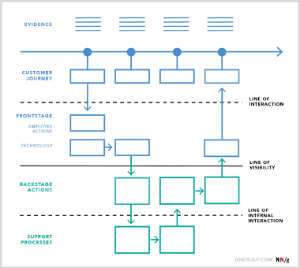Service design is the process of understanding and refining an organization’s people, processes, systems, and policies to improve both the employee experience and, directly and indirectly, the customer’s experience. I communicate to clients a simple 3 step approach to service design including:
Personas -> Journey Maps -> Service Blueprints
In Part 1 we defined customer Personas and in Part 2, stressed that a Journey Map reflects a specific Persona’s experience with an organization. To close out this series on service design, we will discuss what we do with this gained empathy for the customer experience.
Think back to the pre-COVID days when you could get a reservation at a nice restaurant. Chances are, many “cooks” contributed to your dining experience. From the line cook and sous chef to the executive chef and baker, all of these functions contributed to your culinary experience, for better or for worse.

Yet if we took the role of food critic, our review would reflect our experience in the dining area, not what may or may not have happened in the kitchen. While a journey map reflects the customer view of the “dining room” experience (i.e., what the customer sees), a service blueprint is an artifact that visually describes the “kitchen” - how the people, processes, and physical (or digital) resources ultimately supports a specific journey.
Think of service blueprints as the flip side of the same coin, yet representing the employee experience. So what is this artifact and what do we do with it? A service blueprint provides details about how employees support a specific customer journey. So, what types of information should a good service blueprint include?

A service blueprint recipe of basic ingredients should include:
Service blueprints must be created by pulling frontstage and backstage inputs from real employee accounts and validated through internal research. This research and validation will likely need to traverse functional groups across an organization. Some key benefits of this work and the resulting artifact(s) include: